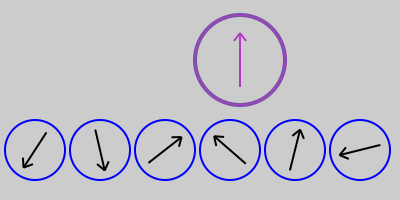Sony TV Woes

Friday, I called Sony about the issue; from information on the web it appears to be a known manufacturing defect. Sony said that they would get back to me within two business days about what they might do. Allegedly, Sony can't really fix the problem. The best they can do is replace the "optical block" unit with one that is just as likely to fail within 2 to 5 years. The average lifetime of an LCD display is 60,000 hours; even at 10 hours/day that's 16 years. It's not unreasonable to expect that a TV of this price should last 10 years.
Belhaven University
We enjoyed our time there; the campus is very appealing and the faculty and students that we met were very nice. It will be interesting to see whether Rachel opts for Belhaven or SCAD.
Modeling Good and Evil, Part III

Model 5
The omission of a "god agent" in no way affects this analysis.
Supposing there are two external standards, we ask the question "which external standard is the best, i.e. most good" or, alternately, "which of these standards ought to be used"?
We can arbitrarily state that the first standard is best, in which case the second standard disappears.
We can arbitrarily state that the second standard is best, in which case the first standard disappears.
We can recognize that a third moral standard is needed to compare against the first two. But if this standard exists, it has to be better than the two it is measuring, in which case it becomes the external standard.
Therefore, if an external moral standard exists, there must be at most one.
Next, does an external standard exist?
Modeling Good and Evil, Part II

Model 3
In model 3, each agent has an internal moral compass. It is assumed that the god-agent is the standard to which all other moral agents should conform. What is good for the god-agent is also good for other moral agents.
Model 4 is the same as model 3, except with the addition of an external moral standard, to which both the god-agent and the other moral agents should conform:

Model 4
With the atheistic models I provided some advocates of each model. I cannot do so, here. That may be because I am not a professional philosopher and simply haven't read the right material.
Eventually, I will argue that both of these theistic models are wrong and will provide a fifth model. But before I do that, I want to examine these models in more detail. For example, two of the four models have one external standard (the "golden" arrow). Why one? Why not two or more? Does this external arrow really exist?
And the polytheists ought to be muttering about the lack of polytheistic models. This, too, deserves attention.
The next post in this category will look at the external standard in more detail.
Proud Father, IV
Modeling Good and Evil, Part I

Model 1
In this model, there are a number of individuals each with their own moral "compass". There is no preferred individual, that is, no one agent's moral sense is intrinsically better (i.e. more moral) than any other's. There is also no external standard of morality to which individual agents ought to conform.
One aspect of this model that should be agreed on is that each agent's moral compass points in a different direction. Pick any contentious subject and it's clear that there is no moral consensus. As the number of agents increases, there will be cases where some compasses point in the same general direction, but whether or not this is meaningful will be discussed later.
Two adherents of this model are the physicist Stephen Weinberg and the philosopher Jean Paul Sarte. Weinberg wrote:We shall find beauty in the final laws of nature, [but] we will find no special status for life or intelligence. A fortiori, we will find no standards of value or morality.
1
Sarte wrote:The existentialist, on the contrary, finds it extremely embarrassing that God does not exist, for there disappears with Him all possibility of finding values in an intelligible heaven. There can no longer be any good a priori, since there is no infinite and perfect consciousness to think it. It is nowhere written that “the good” exists, that one must be honest or must not lie, since we are now upon the plane where there are only men. Dostoevsky once wrote did God did not exist, everything would be permitted”; and that, for existentialism, is the starting point. Everything is indeed permitted if God does not exist, and man is in consequence forlorn, for he cannot find anything to depend upon either within or outside himself.
2
The next model is the same as model 1, with the addition of an external moral compass:

Model 2
There is no universal agreement on where this external source comes from. One adherent of this model is Michael Shermer:... I think there are provisional moral truths that exist whether there’s a God or not. ... That is to say I think it really exists, a real, moral standard like that.
3
Note the violent disagreement between Shermer and Sarte. Later, we will explore whether or not we can determine if either of them are right.
But first, part two will present two more models.
[1] Dreams of a Final Theory: The Search for the Fundamental Laws of Nature.
[2] Existentialism Is a Humanism
[3] Greg Koukl and Michael Shermer at the End of the Decade of the New Atheists

